Business Impact Analysis: What it is and how to do it

The crucial issue of comprehending and minimizing the possible effects of disruptions on an organization’s operations is aided by business impact analysis. Business impact analysis (BIA) empowers organizations to devise effective contingency plans and optimize resource use.
By assisting in the anticipation of potential interruptions like supply chain breakdowns, cyberattacks, and natural disasters, businesses can reduce financial loss and downtime while maintaining critical operations.
Did you know that in 2023, the average cost of a data breach reached an all-time high of USD 4.45 million? This figure represents a 15% increase over the past three years and highlights the growing financial impact of data breaches on organizations worldwide (IBM).
The rising costs of breakdowns in critical operations represent the dire need for business impact analysis.
Additionally, by offering data-driven insights to support decision-making, business impact analysis assists businesses in meeting industry standards and regulatory requirements for risk management and business continuity.
In this article, you will learn all about business impact analysis and how to conduct it for your organization.
Section 1: Understanding business impact analysis
Definition of business impact analysis
Business impact analysis is the methodical process of identifying and assessing the possible consequences of disruptions to crucial business processes. It determines a company’s core operations, evaluates the possible effects of different interruptions, and aids in the creation of recovery plans.
The scope of a business impact analysis can include and not be restricted to decreased sales, higher costs, and other variables that impact revenue and service provision.
In order to maintain business continuity, the analysis comprises identifying risks to service delivery and establishing recovery objectives, such as Recovery Time Objectives (RTO) and Recovery Point Objectives (RPO). We will explore the core principles of BIA in more detail.
Core components and principles of business impact analysis
Business impact analysis is a critical process for understanding the potential effects of disruptions on business operations.
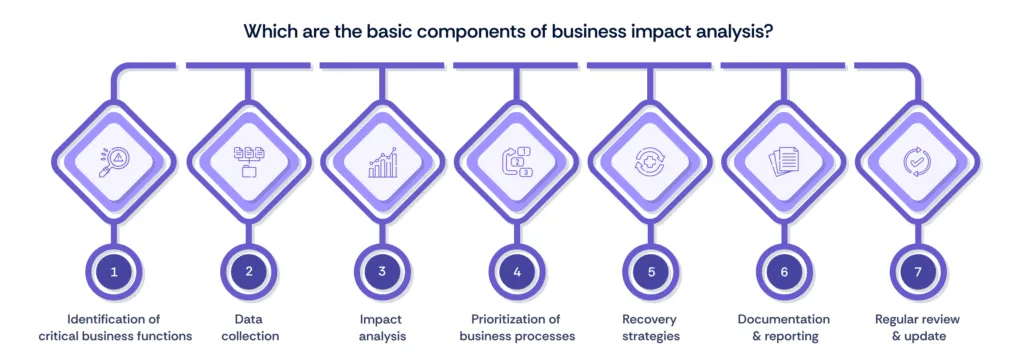
The core components and principles of BIA include:
- Identification of critical business functions: BIA identifies essential business functions, systems, staff, and technology resources that are crucial for the organization’s operations to run optimally.
- Data collection: Gathering detailed information about business processes, resources, dependencies, and potential threats. This data is used to understand how disruptions might affect these areas.
- Impact analysis: Evaluating the operational and financial impacts of various disruptions. This includes examining the effects on financial performance, reputation, regulatory compliance, production output, and the environment.
- Prioritization of business processes: Ranking business processes and functions based on their criticality and the severity of impact if disrupted. This helps in focusing recovery efforts on the most vital areas.
- Recovery strategies: Developing strategies and plans to mitigate the identified impacts. This involves determining RTO and RPO to ensure the timely recovery of critical functions.
- Documentation and reporting: Creating detailed reports that document the findings of the BIA, including the identified risks, impact assessments, and recommended recovery strategies. This documentation is essential for communicating the analysis to stakeholders and for ongoing review and improvement.
- Regular review and update: Continuously updating the BIA to reflect changes in the business environment, technology, and processes. Regular reviews ensure that the BIA remains relevant and effective.

Business impact analysis is crucial in business continuity and risk management for several reasons:
Identification of critical functions: BIA helps organizations identify their most critical business functions, systems, and processes. This understanding is essential for prioritizing recovery efforts and ensuring that the most vital operations can continue during and after a disruption.
Predicting consequences of disruptions: BIA allows businesses to predict the operational and financial impacts of various disruptions, such as natural disasters, cyber-attacks, or supply chain failures. This foresight helps in developing strategies to mitigate these impacts effectively.
Minimizing business risks: By understanding potential threats and their impacts, organizations can implement measures to minimize business risks. This proactive approach helps in reducing the likelihood of significant losses and ensures business continuity.
Resource allocation: BIA provides insights into the resources required for maintaining critical functions during a disruption. This ensures efficient allocation of resources, reduces wastage, and ensures that essential operations have the necessary support.
Enhancing recovery planning: A well-conducted BIA is integral to a robust Business Continuity Plan (BCP). It informs the development of recovery strategies and action plans, ensuring that businesses can recover quickly and effectively in the aftermath of a disaster.
Improving decision-making: The data-driven insights gained from BIA support better decision-making in risk management. Organizations can make informed choices about where to invest in preventive measures and how to structure their continuity plans.
Differences between BIA and risk assessment
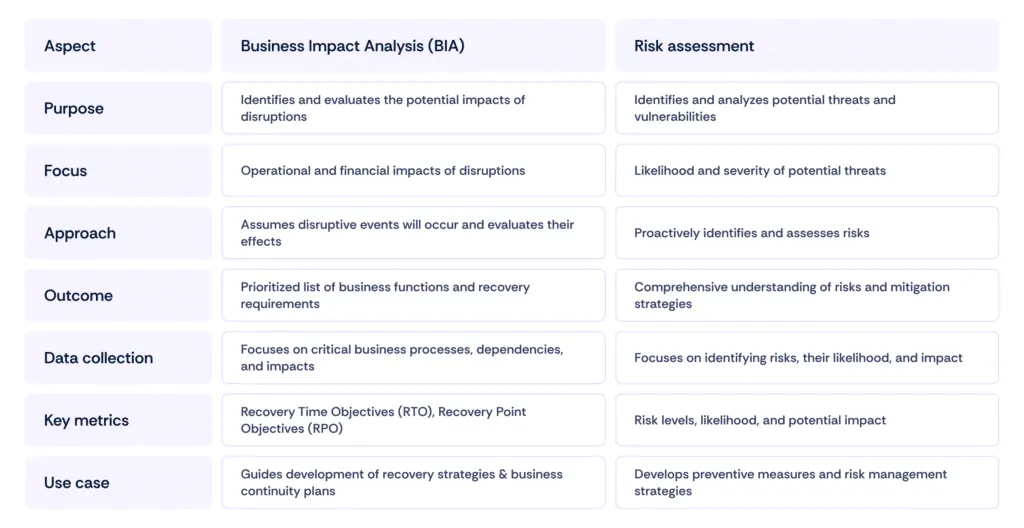
Potential consequences of not conducting a BIA
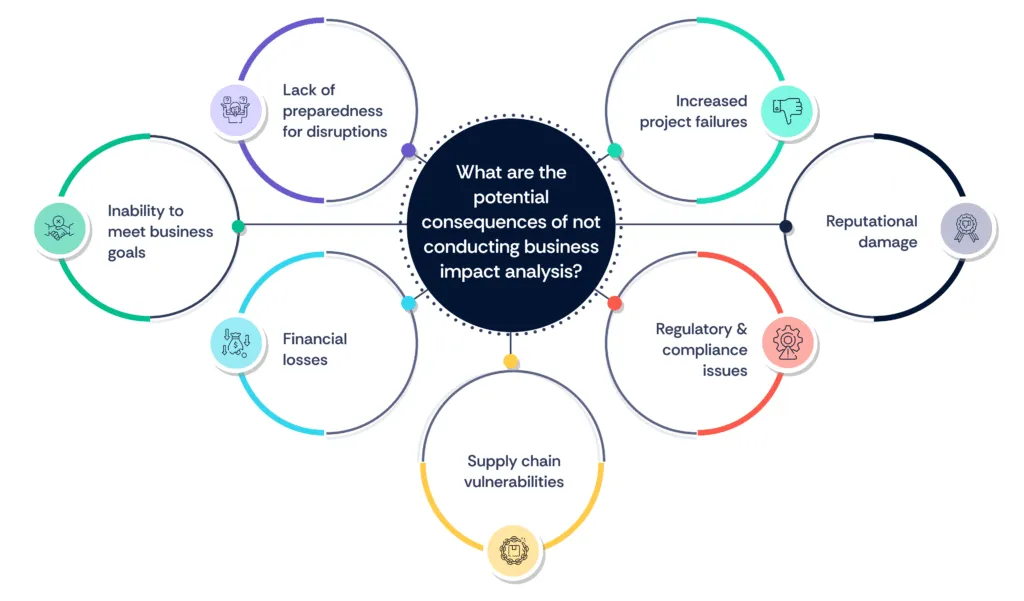
Not conducting a Business Impact Analysis (BIA) can lead to several severe consequences for an organization:
- Lack of preparedness for disruptions: Without a BIA, a business may not fully understand the potential impacts of disruptions on its critical functions, leading to inadequate preparedness and response plans.
- Inability to meet business goals: There can be a misalignment between application performance and management’s expectations, resulting in inefficiencies and potential failures in delivering key services.
- Financial losses: A failure to predict and plan for the financial impacts of disruptions can result in significant financial losses due to unexpected downtime, lost sales, and increased recovery costs.
- Supply chain vulnerabilities: Not conducting a BIA can lead to gaps in the supply chain, making it difficult to identify and mitigate risks, which can disrupt production and delivery processes.
- Regulatory and compliance issues: Without carrying out a BIA, organizations may fail to meet regulatory and compliance requirements related to risk management and business continuity, potentially leading to legal and financial penalties.
- Reputational damage: Inadequate response to disruptions can damage an organization’s reputation, as stakeholders may lose trust in its ability to manage risks and ensure continuous operations.
- Increased project failures: The absence of impact analysis can lead to unforeseen consequences that may cause projects to fail, as potential risks and impacts are not adequately identified and mitigated.
What is privacy impact assessment? How does it differ from business impact analysis?
Privacy Impact Assessment (PIA) is a process used to identify and assess privacy risks associated with the collection, use, and disclosure of personal information in a program or system. Data privacy impact assessment helps organizations ensure that they are compliant with privacy laws and regulations and that privacy risks are managed effectively throughout the development lifecycle of their projects.
Business impact analysis examples
Several businesses have successfully used Business Impact Analysis to improve their resilience and operational continuity. Given below are examples of how BIA helps organizations ensure operational continuity and resilience:
Microsoft
Microsoft uses BIA to analyze potential disruptions and their impacts on its extensive network of services and operations. This proactive approach helps enhance productivity and collaboration by ensuring seamless service delivery and mitigating risks associated with operational disruptions.
Coca-Cola
Coca-Cola employs BIA to improve its customer knowledge and refine its supply chain management. By understanding the potential impacts of disruptions on their supply chain and customer relations, Coca-Cola can develop effective strategies to maintain continuous operations and meet customer demands around reliable and convenient delivery.
Manufacturing companies
Many manufacturing companies use BIA to understand how disruptions, such as equipment failure or supply chain interruptions, can affect production and delivery. For example, a manufacturing company might use BIA to analyze the effects of a pandemic on their operations and develop contingency plans to address these challenges.
Healthcare organizations
Healthcare providers often use BIA to ensure that critical medical services remain available during emergencies. By evaluating the potential impacts of various disruptions, such as natural disasters or cyber-attacks, healthcare organizations can prioritize essential services and allocate resources effectively to maintain patient care.
Read also: Guardians of healthcare data: Mastering HIPAA audit trail requirements
Section 2: Steps to conduct a business impact analysis

Step 1: Preparation

- Establishing a BIA team
- Assemble a team: Create a dedicated BIA team that includes representatives from various departments such as IT, HR, operations, finance, and customer service to create and execute a holistic BIA process.
- Assign roles and responsibilities: Clearly define the roles and responsibilities of each team member to ensure that all aspects of the BIA are covered effectively.
- Defining the scope and objectives
- Determine objectives: Clearly outline the goals of the BIA. This includes understanding the potential impacts of disruptions, prioritizing business functions, and identifying critical resources to monitor.
- Set the scope: Define the scope of the analysis by determining which business units, processes, and systems will be included. This helps focus the BIA on the most crucial areas and ensures that the analysis is manageable and effective.
Step 2: Data collection

- Identifying critical business functions and processes
- Identify vital business processes: Determine which business functions and processes are critical to the organization’s operations by understanding the dependencies and interdependencies within the organization.
- Engage with stakeholders: Involve key stakeholders and process owners to gain insights into the importance and impact of various business functions. This ensures that all critical areas are covered and accurately assessed.
- Collecting relevant data
- Interviews: Conduct interviews with department heads, managers, and other relevant personnel to gather detailed information about their priorities, processes, dependencies, and potential disruption impacts. These interviews provide qualitative insights that are crucial for a comprehensive analysis.
- Surveys: Utilize online and offline surveys, like a business impact analysis questionnaire, to collect quantitative data from a broader group of employees. Such surveys can help quantify the potential impacts of disruptions and prioritize business functions based on their criticality.
- Document analysis: Review existing documentation, such as process maps, standard operating procedures, and previous incident reports, to understand the current state of business operations and the historical impacts of disruptions.
- Use various data collection tools: Employ tools such as QuestionPro for surveys, business impact analysis software, and document management systems to streamline the data collection process and ensure comprehensive coverage.
Step 3: Analyzing data
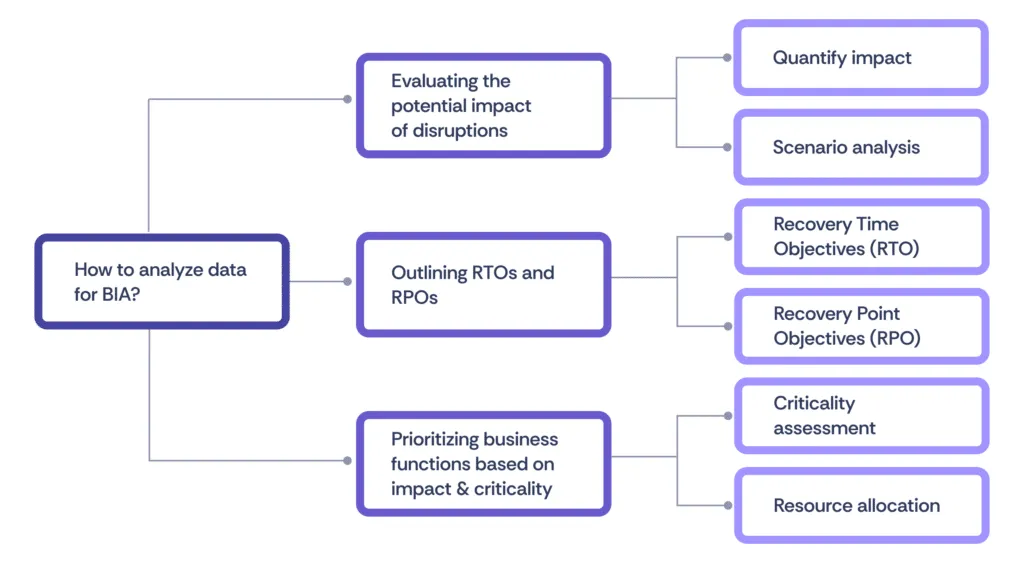
- Evaluating the potential impact of disruptions
- Quantify impact: Assess the operational and financial impacts of disruptions on critical business functions. This includes evaluating the effects on service delivery, revenue, regulatory compliance, and reputation.
- Scenario analysis: Use various disruption scenarios to understand how different types of interruptions could affect the organization. This helps identify the most significant risks and prepare appropriate mitigation strategies.
- Outlining RTOs and RPOs
- Recovery Time Objectives (RTO): Determine the maximum acceptable downtime for each critical function. RTO defines how quickly systems and processes need to be restored after a disruption to avoid significant impacts on operations.
- Recovery Point Objectives (RPO): Establish the maximum acceptable amount of data loss measured in time. RPO indicates the age of files that must be recovered from backup storage for normal operations to resume.
- Prioritizing business functions based on impact and criticality
- Criticality assessment: Rank business functions based on their importance to the organization and the severity of impact if disrupted. Consider factors such as financial implications, legal requirements, customer impact, and operational dependency.
- Resource allocation: Allocate resources and prioritize recovery efforts to ensure that the most critical functions are restored first. This prioritization ensures that the organization can maintain essential services and minimize disruption effects.
Step 4: Developing recovery strategies
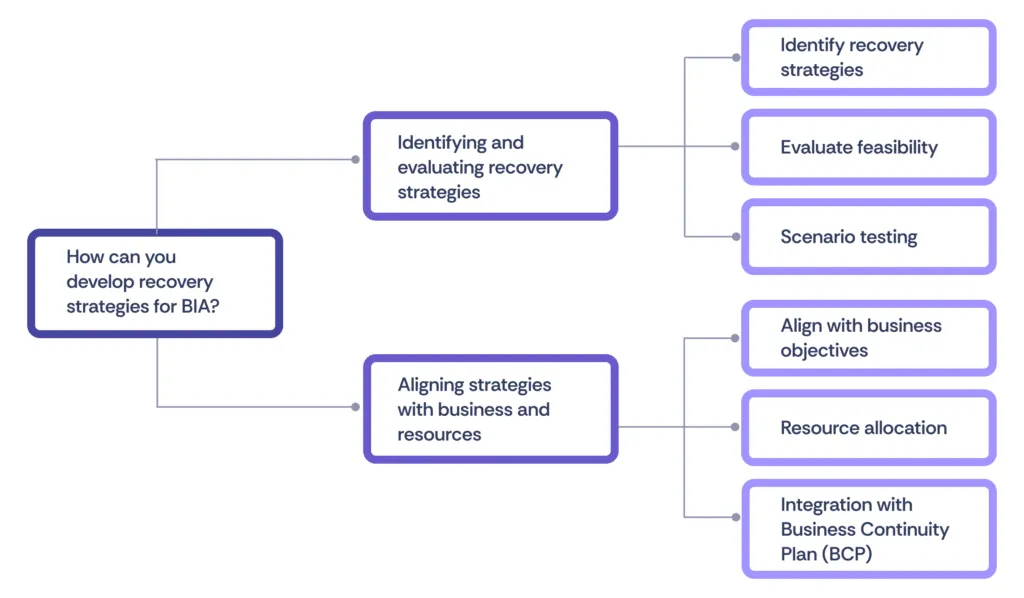
- Identifying and evaluating recovery strategies
- Identify recovery strategies: Develop a range of potential recovery strategies for each critical business function and process. These strategies should address different types of disruptions, including natural disasters, cyber-attacks, and supply chain interruptions.
- Evaluate feasibility: Assess the feasibility of each recovery strategy in terms of cost, time, and resources required. Consider the effectiveness of each strategy in minimizing downtime and financial impact.
- Scenario testing: Perform scenario testing to evaluate how each recovery strategy performs under different disruption scenarios. This helps identify the most robust and effective strategies.
- Aligning strategies with business and resources
- Align with business objectives: Ensure that the recovery strategies are aligned with the organization’s overall business objectives. This alignment ensures that the strategies support the long-term goals and priorities of the business.
- Resource allocation: Allocate the necessary resources to implement the chosen recovery strategies, including financial resources, personnel, and technology. Effective resource allocation ensures that the strategies can be executed efficiently and effectively.
- Integration with Business Continuity Plan (BCP): Integrate the developed recovery strategies into the broader business continuity plan. This ensures a coordinated and comprehensive approach to managing disruptions and maintaining business continuity.
Step 5: Documentation and Reporting
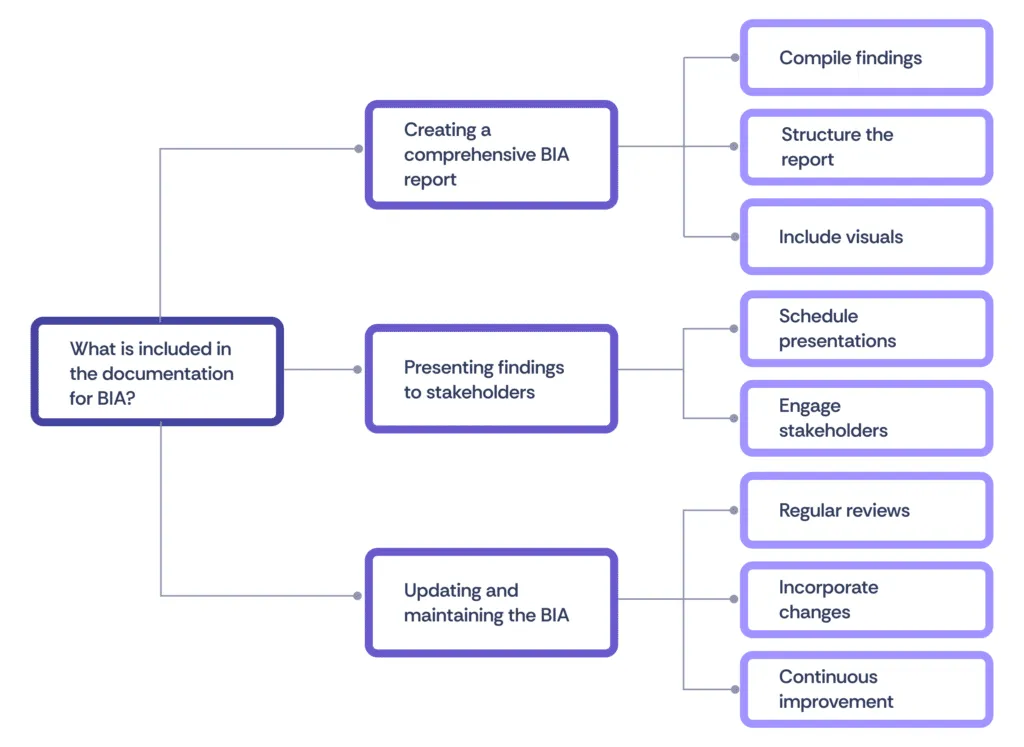
- Creating a comprehensive BIA report
- Compile findings: Gather all the data collected during the BIA process, including critical business functions, potential impacts of disruptions, recovery strategies, and priorities.
- Structure the report: Organize the report with an executive summary, methodology, detailed findings, impact analysis, and recommended recovery strategies. Ensure clarity and coherence for stakeholders to understand easily.
- Include visuals: Utilize charts, graphs, and tables to present data effectively. Visual aids can help illustrate complex information and highlight key points.
- Presenting findings to stakeholders
- Schedule presentations: Periodically arrange meetings with upper management and key stakeholders to present the BIA findings. This ensures that the critical decision-makers understand the potential impacts and proposed recovery strategies.
- Engage stakeholders: Present the BIA report clearly and concisely, highlighting the most critical findings and recommended actions. Then, stakeholders will be engaged in discussions to address any concerns and gather feedback.
- Updating and maintaining the BIA
- Regular reviews: Establish a schedule for regular reviews and updates of the BIA. This ensures that the analysis remains current and relevant as the business environment and operations change.
- Incorporate changes: Update the BIA report with any changes in business processes, technology, regulatory requirements, or organizational structure. Regular updates ensure the BIA reflects the most accurate and up-to-date information.
- Continuous improvement: Use feedback from stakeholders and lessons learned from actual disruptions to continuously improve the BIA process. This iterative approach helps in enhancing the effectiveness of the BIA over time.
Section 3: Common challenges and how to overcome them

BIA: Key to more resilient operations
In conclusion, a Business Impact Analysis (BIA) is crucial for organizations to prepare for and mitigate potential disruptions. By identifying and evaluating the effects of interruptions, a BIA helps in creating effective contingency plans, optimizing resources, and ensuring compliance with industry standards. This proactive approach reduces financial losses and downtime while enhancing decision-making through data-driven insights.
Integrating BIA into your business continuity and risk management framework ensures preparedness, maintains essential operations, and supports long-term success in a dynamic environment.
Ready to safeguard your business against potential risks and disruptions? Discover how a comprehensive risk assessment with Scrut can help you identify vulnerabilities, ensure compliance, and maintain business continuity. Don’t wait for a crisis to occur.
Contact Scrut today and take the first step towards a more resilient future!
FAQs
1. What is Business Impact Analysis?
Business Impact Analysis (BIA) is a methodical process used to identify and assess the potential consequences of disruptions to crucial business processes. It helps organizations determine core operations, evaluate the effects of various interruptions, and create recovery plans to maintain business continuity.
2. Why is a BIA important for my organization?
BIA is important because it helps organizations anticipate and mitigate potential disruptions, such as supply chain breakdowns, cyberattacks, and natural disasters. This preparation minimizes financial losses and downtime, ensures compliance with regulatory requirements and supports effective risk management.
3. How can BIA improve decision-making in risk management?
BIA provides data-driven insights that support better decision-making by helping organizations understand potential impacts, prioritize recovery efforts, allocate resources efficiently, and develop effective recovery strategies. This informed approach enhances overall risk management and business continuity planning.
4. How to start a BIA?
The first step in the Business Impact Analysis (BIA) process is the preparation stage, during which the company appoints a dedicated team responsible for conducting the BIA. This team defines the scope and objectives of the analysis. Subsequently, data collection begins using various methods such as interviews, questionnaires, surveys, and document analysis. Once gathered, the data is analyzed to evaluate the potential impact of disruptions. The team then prioritizes business functions based on their impact and criticality. Strategies are developed to recover these critical business functions in the event of a disruption. All steps and findings are meticulously documented and presented to relevant stakeholders. To ensure its relevance and effectiveness, the BIA plan should be reviewed and updated regularly.


















